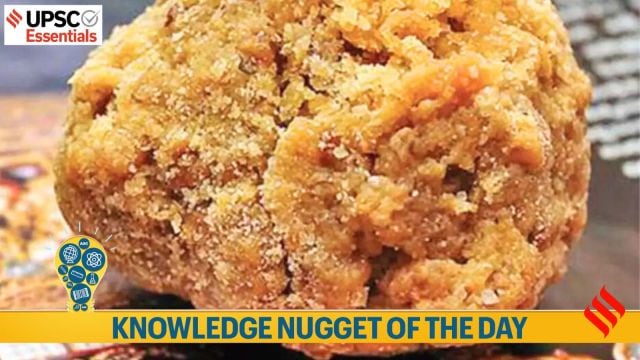
Knowledge Nugget: Tirupati Laddu
Subject: Art and Culture
Why in news?
Andhra Pradesh Chief Minister N. Chandrababu Naidu has alleged that during the previous YSRCP regime, animal fat was used to prepare the Tirupati laddu prasadam at Tirumala. The opposition has dismissed the allegation and challenged Naidu to provide evidence. Meanwhile, in the backdrop of this controversy, the VHP on Tuesday announced a campaign to free temples across the country from government control.
The Tirumala Tirupati Devasthanams (TTD) also stated that purification rituals were performed in and around the Sri Venkateswara temple to “ward off ill effects and restore the sanctity of laddoo prasadams.”
Key Takeaways :
1. The famous Tirupati laddu prasadam of Lord Venkateswara is now over 300 years old. The temple at Tirupati started offering the laddu to the Lord and as prasadam to devotees in 1715.
2. The prasadam is prepared in a special kitchen known as Potu, by laddu makers who belong to a particular sect that has been doing this work for centuries. The laddu makers have to shave their heads, and they have to wear a single clean cloth while in the kitchen.
3. The first laddu of each batch is offered to the Lord, which is then mixed with the rest of the preparation and distributed to the devotees. The temple offers one laddu free to everyone while exiting the temple, and larger quantities of the prasadam can be purchased at Rs 50 per laddu.
Story continues below this ad
4. Pure, high-quality ghee, chickpea gram flour, sugar, small sugar cubes, cashew nut, cardamom, camphor, and raisins go into the preparation of the laddu.
 Tirupati Laddu on Indian stamp
Tirupati Laddu on Indian stamp
5. Each laddu must have precise quantities of cashew, sugar, and cardamom, and the weight of the laddu should be 175 grams. (The precise measurements are also a requirement for the GI tag.)
6. Tirumala Tirupati Devasthanams (TTD), which runs the Sri Venkateswara Temple at Tirupati, has a state-of-the-art food testing laboratory that conducts quality checks on a laddu from each batch.
7. Tirupati laddu received the geographical indication (GI) tag in 2009 which was renewed in 2018 and is applicable till 2028.
JUST FYI:
Story continues below this ad
The country’s apex food safety regulator has sent a show cause notice to A R Dairy, which was one of the suppliers of ghee to the Sri Venkateswara temple in Tirupati, asking why its licence should not be suspended as its product allegedly did not meet the standards set for ghee.
BEYOND THE NUGGET: Geographical Indication (GI) Tag & Sri Venkateswara Temple
1. A GI tag is conferred upon products originating from a specific geographical region, signifying unique characteristics and qualities. Essentially, it serves as a trademark in the international market.
2. In India, the Department for Promotion of Industry and Internal Trade, Ministry of Commerce and Industry, awards GIs.
2. Sri Venkateswara Temple is constructed in Dravidian style of temple architecture.
3. The Dravidian style of temple architecture was widespread in Karnataka, Andhra Pradesh, and northern Tamil Nadu. Characteristics of Dravidian Temple Architecture are:
Story continues below this ad
— The temple is enclosed within a compound wall. The front wall has an entrance gateway in its center, which is known as a gopuram.
— The shape of the main temple tower, vimana, is like a stepped pyramid that rises up geometrically.
— The word ‘shikhara’ is used only for the crowning element at the top of the temple which is usually shaped like a small stupika or an octagonal cupola.
— Large water reservoir or a temple tank is enclosed within the complex.
Story continues below this ad
— The subsidiary shrines are either incorporated within the main temple tower or located as distinct, separate small shrines beside the main temple.
(Source: Chandrababu Naidu alleges animal fat in Lord’s laddu )
For your queries and suggestions write at roshni.yadav@indianexpress.com
Subscribe to our UPSC newsletter and stay updated with the news cues from the past week.
Story continues below this ad
Stay updated with the latest UPSC articles by joining our Telegram channel – Indian Express UPSC Hub, and follow us on Instagram and X.



 Tirupati Laddu on Indian stamp
Tirupati Laddu on Indian stamp






























